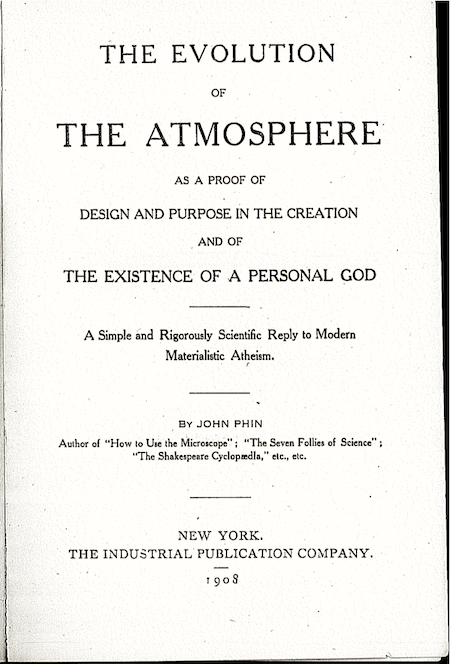John Wilkins has a nice post up at Evolving Thoughts examining the early uses of the term “intelligent design.” He uses Google n-grams to dig up early uses of the phrase, then examines how people were interpreting the phrase:
It is clear from these readings, that the design argument was used in the same fashion [as by modern ID creationists] after natural theological uses fell out of favour. The natural theologians argued from the appearance of design in the world to the properties of the deity. Modern designism argues from the appearance of design in the world to the existence of the deity, and then tries to show that the design is irreducible, in Kant’s sense.
In the comments, Adam Shapiro and former NCSE staffer Nick Matzke offer some useful caveats. Shapiro observes:
…briefly, though Paley, the assorted Bridgewater authors, later Victorians, and the Discovery Institute crowd have all used the phrase “intelligent design”, what they mean by both intelligence and designer change a lot. And more importantly, they use very different modes of reasoning from nature to these apparently similar conclusions...
While Matzke observes that the modern ID creationist movement’s use of the term has to be a convergent evolution, not a continuing use of any single idea:
I think it is only mildly interesting [to] trace the conjunction of the two words “intelligent design” through history. It’s not really a “term” for most of its history, it’s just people talking about the Design Argument, and in such discussions they occasionally put together the words “intelligent” and “design”, usually more rarely than a variety of other combinations—“intelligent cause”, “beneficient design”, “creative design”, “designing mind”, or, mostly, just “design” or “Design.”…
The real origin of ID, as a term, is in the 1980s, and I think it was arrived at more by a process of elimination than as a particularly well thought-out positive choice. Anything mentioning “creation” was out for the reasons we all know about, and they were also trying to avoid association with the Design Argument. This basically left “intelligent cause” and “intelligent design”, and they picked the latter for Of Pandas and People...
 Bearing all that in mind, I want to add one item to Wilkins’s dataset. It’s actually a book Nick alerted me to some years back, a 1908 volume by John Phin, titled: The Evolution of the Atmosphere as a Proof of Design and Purpose in the Creation and of the Existence of a Personal God, a Simple and Rigorously Scientific Reply to Modern Materialistic Atheism (they don’t make titles like they used to).
Bearing all that in mind, I want to add one item to Wilkins’s dataset. It’s actually a book Nick alerted me to some years back, a 1908 volume by John Phin, titled: The Evolution of the Atmosphere as a Proof of Design and Purpose in the Creation and of the Existence of a Personal God, a Simple and Rigorously Scientific Reply to Modern Materialistic Atheism (they don’t make titles like they used to).
In his preface, Phin gives this précis of the book’s argument:
The great contest which is at present waged between Christian theists and materialistic atheists—a contest over the fundamental principles of all religion, since it relates to the affirmation or denial of the very existence of God—unquestionably turns upon the presence or absence of design in creation. Haeckel, whose words I have quoted on an early page, denies that there is any evidence of design and attributes everything to what he calls “blind chance.” It follows, as a matter of course that he and his followers take the very logical position: “No design, no designer; therefore, no God.” And as such men as Professor Seth of Edinburgh University and others take the ground (unwarrantably, perhaps) that modern scientific discoveries and especially the doctrine of evolution, destroy the force of such arguments as those used by Paley and the Bridgewater men, the author of the present volume has attempted to prove by a new and, as he thinks, a stronger argument than any that has ever before been presented, that this earth was created as the result of intelligent design and consequently by a self-conscious and intelligent Designer.
For the purpose of distinctly indicating the argument of this book, it may be conceded that the theory of evolution, as applied to the organic world, has swept away the whole logical fabric constructed by Paley and his followers: that no direct indication of design can now be found in any of the marvelous adaptations of animal and vegetable life to the conditions in which such life exists; that chance, “blind chance” with its millions of experiments in all directions, can, under the law of natural selection, account for all the forms of life in the world, including the body and the mind of man.
What this little book endeavors to show is that the proof of design in certain adaptations and necessary conditions, exhibited in the inorganic world—in the atmosphere which is essential to all the higher forms of life—is absolute and stands unaffected by any theory of evolution. There can be no struggle for existence between oxygen and nitrogen; no instance of the survival of the fittest can be pointed out among the different elements which compose the life-giving, life-supporting air. There has been no long series of experiments and no competition, among innumerable atmospheres to determine which should envelop the earth and establish conditions essential to, the evolution of human life. The laws of natural selection may account for a Lord Kelvin, but these laws could have come into action only after some amazingly powerful and cunning chemist had, with a precision and minute adjustment of proportions almost beyond conception, selected and set apart such an assortment of ingredients as would ultimately produce an atmosphere in which it might be possible for a Lord Kelvin to be evolved.
A very simple calculation which is easily within the comprehension of any bright grammar-school graduate, shows clearly that the proportions of the essential ingredients which compose this earth and its atmosphere must have been adjusted to the one-ten-millionth part of the materials employed and that a variation to the extent of one-five-millionth part on either side of a certain very definite quantity, would have rendered all life, as we know it, utterly impossible. Such a nice adjustment as this could never have been brought about either by chance or by the operation of any known physical or chemical laws.
And so forth. This is largely a run-of-the-mill fine-tuning argument, down to the argument from incredulity and the argument from ill-computed probabilities. There are early stabs at irreducible complexity, and even an attempt at something like ID creationist Bill Dembski’s universal probability bound: “there is only one chance in ten millions that the present order of things came into being otherwise than by the intelligent design of a supreme guiding Power, and this amounts to almost absolute impossibility.” But such arguments are hardly novel to Phin.
I’m nonetheless fascinated by it for three reasons.
First, for the early use of “intelligent design” and “intelligent designer.” Not by any stretch the earliest: Wilkins stopped his search in 1884 because people seem to have settled on a consistent usage by then. And Phin’s use is totally consistent with the trend Wilkins describes, the use of “design” as evidence for the existence, rather than the nature, of a creator.
Second, for its frank willingness to concede that biological evolution renders design arguments in biology moot. He hedges about whether he actually accepts evolution, but doesn’t choose to fight that battle. If only more creationists were willing to go so far!
Third, his focus on the atmosphere (and to some extent its implications for climate). Alas, Phin doesn’t seem to discuss the greenhouse effect, and his discussion of “carbonic acid” (rather than carbon dioxide) doesn’t offer a historical antecedent to any claims in modern battles over climate change (except to claim that industrial carbon dioxide emissions “would not sensibly affect the purity of the atmosphere in less than 50,000 years,” a claim Arrhenius had disproven a decade earlier). But some modern climate change deniers (including many associated with creationist institutions) do argue that the atmosphere has a system of feedback loops so carefully balanced and counterbalanced as to render dangerous climate change impossible.
What would Phin make of today’s research on climate change? Would he side with the climate change deniers, insisting that the atmospheric ratios can’t change dangerously because of the atmosphere’s intelligent design? The modern evidence from paleoclimatology doesn’t leave much room for that view. Ratios of atmospheric gases have varied widely over time, responding to changes in life on earth, and causing changes in life.
Then again, if the ratios of atmospheric gases were set by an intelligent designer, what does it say about the wisdom of the massive changes that began with the Industrial Revolution, and will continue so long as society relies on the burning of fossil fuels for energy? John Phin didn’t say. Some Christians read God’s grant of “dominion” over the earth to mean that it is an insult not to use what the creator of fossil fuels has provided, and hold that God’s benevolence would keep us from damaging creation in the course of exercising our dominion. On the other hand, the Creation Care movement sees an urgency in action to stop climate change precisely because of their religious conviction that this world (including its atmosphere and climate) was created by a supreme intelligence, and that the creation story in Genesis gives humans a duty to protect that delicate balance.

